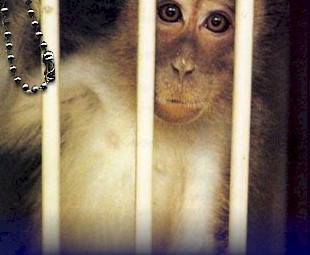| Squirrel
Monkeys In The Wild
 Squirrel
monkeys live within most of the rain forests of the northern Amazon
Basin. In the wild, they prefer the middle canopy where they search
for insects and fruit. These monkeys also eat snails, arthropods,
and small vertebrates such as tree frogs. Male squirrel monkeys
are unique among primates because they become "fatted"
-- putting on weight in the upper torso -- during the breeding season.
The squirrel monkey group size varies from a small group of ten
to more than two hundred individuals in undisturbed Amazon rain
forests. Squirrel
monkeys live within most of the rain forests of the northern Amazon
Basin. In the wild, they prefer the middle canopy where they search
for insects and fruit. These monkeys also eat snails, arthropods,
and small vertebrates such as tree frogs. Male squirrel monkeys
are unique among primates because they become "fatted"
-- putting on weight in the upper torso -- during the breeding season.
The squirrel monkey group size varies from a small group of ten
to more than two hundred individuals in undisturbed Amazon rain
forests.
Read
about the conditions of squirrel monkeys in two separate labortories.
Squirrel Monkey Breeding
and Research Resource - Mobile, Alabama
University of California
-- San Francisco, California
Rhesus
Macaques in the wild
In The Wild
Rhesus macaques roam extensive territories in multi-male groups
with strong male and female hierarchies. Dominance is conveyed via
 the
maternal lineage. Rhesus macaques have evolved complex minds capable
of keeping track of who is whose mother, grandmother, brother, sister,
son, daughter, cousin, ad infinitum. These complex minds
have led them to develop sophisticated communication methods including
body postures, facial expressions, and auditory calls; the meanings
of which are still generally unclear to researchers. These complex
minds allow the monkeys to spend their days in exploration and creative
play. Rhesus macaques have lived alongside human settlements for
centuries. the
maternal lineage. Rhesus macaques have evolved complex minds capable
of keeping track of who is whose mother, grandmother, brother, sister,
son, daughter, cousin, ad infinitum. These complex minds
have led them to develop sophisticated communication methods including
body postures, facial expressions, and auditory calls; the meanings
of which are still generally unclear to researchers. These complex
minds allow the monkeys to spend their days in exploration and creative
play. Rhesus macaques have lived alongside human settlements for
centuries.
In The Labs
 Rhesus macaques have
become the primary target of biomedical and behavioural research
using primates. Their relative willingness to breed in captivity
has made them the monkey of choice for scientists. "Breeders"
are kept in corrals in groups to approximate normal social settings.
It has been learned that monkeys raised outside these settings rarely
become successful caregivers to their own offspring. Rhesus macaques have
become the primary target of biomedical and behavioural research
using primates. Their relative willingness to breed in captivity
has made them the monkey of choice for scientists. "Breeders"
are kept in corrals in groups to approximate normal social settings.
It has been learned that monkeys raised outside these settings rarely
become successful caregivers to their own offspring.
Once "harvested" from the breeding corrals infants are
typically moved to a "nursery" and kept with one other
cage-mate. There they await an assignment to a particular study.
Once assigned, Rhesus macaques are commonly caged individually.
Often, monkeys caged in these solitary situations develop self-injurious
behaviors such as self-biting, hair pulling, and repetitive motions.
Animals who have evolved to keep track of complex social interactions
among large groups are reduced to entertaining themselves in small
mind-numbing cubicles.
Crab-eating
or Long-Tailed macaques
In The Wild
The long-tailed or crab-eating macaques are native to the rain forests
of Southeast Asia. They get their names from their long  graceful
tails. Crab-eating macaques' tails are so long that they touch the
ground when they walk. These beautiful monkeys often feed on crabs
and shellfish in mangrove swamps. This highly adaptable species
prefers to live near rivers or coastal forests, but can live just
as easily in disturbed habitats. Often, human alterations have proved
beneficial to crab-eating macaques by providing additional food
sources, such as rice, cassava leaves, and taro plants. Crab-eating
macaques utilize a variety of alarm calls, loud screeches, and shrieks,
as well as an animated repertoire of facial gestures to communicate
with each other, some of which are quite subtle. graceful
tails. Crab-eating macaques' tails are so long that they touch the
ground when they walk. These beautiful monkeys often feed on crabs
and shellfish in mangrove swamps. This highly adaptable species
prefers to live near rivers or coastal forests, but can live just
as easily in disturbed habitats. Often, human alterations have proved
beneficial to crab-eating macaques by providing additional food
sources, such as rice, cassava leaves, and taro plants. Crab-eating
macaques utilize a variety of alarm calls, loud screeches, and shrieks,
as well as an animated repertoire of facial gestures to communicate
with each other, some of which are quite subtle.
In The Labs
At the Washington Regional Primate Research Center, Thomas M. Burbacher
is studying the effects of mercury in crab-eating macaques that
were intentionally poisoned as fetuses. He is also subjecting pregnant
crab-eating macaques to varying concentrations of inhaled methanol.
He is curious whether their babies will be affected.
Primate Centers Currently Housing Crab-eating Macaques:
Oregon Regional Primate Research
Center
Washington Regional Primate Research
Center
California Regional Primate Research
Center
Home Page | Our Mission | News
What Are Primate Freedom
Tags | Order Tag
Primate Research
Centers | Resources
|







 Squirrel
monkeys live within most of the rain forests of the northern Amazon
Basin. In the wild, they prefer the middle canopy where they search
for insects and fruit. These monkeys also eat snails, arthropods,
and small vertebrates such as tree frogs. Male squirrel monkeys
are unique among primates because they become "fatted"
-- putting on weight in the upper torso -- during the breeding season.
The squirrel monkey group size varies from a small group of ten
to more than two hundred individuals in undisturbed Amazon rain
forests.
Squirrel
monkeys live within most of the rain forests of the northern Amazon
Basin. In the wild, they prefer the middle canopy where they search
for insects and fruit. These monkeys also eat snails, arthropods,
and small vertebrates such as tree frogs. Male squirrel monkeys
are unique among primates because they become "fatted"
-- putting on weight in the upper torso -- during the breeding season.
The squirrel monkey group size varies from a small group of ten
to more than two hundred individuals in undisturbed Amazon rain
forests.
 the
maternal lineage. Rhesus macaques have evolved complex minds capable
of keeping track of who is whose mother, grandmother, brother, sister,
son, daughter, cousin, ad infinitum. These complex minds
have led them to develop sophisticated communication methods including
body postures, facial expressions, and auditory calls; the meanings
of which are still generally unclear to researchers. These complex
minds allow the monkeys to spend their days in exploration and creative
play. Rhesus macaques have lived alongside human settlements for
centuries.
the
maternal lineage. Rhesus macaques have evolved complex minds capable
of keeping track of who is whose mother, grandmother, brother, sister,
son, daughter, cousin, ad infinitum. These complex minds
have led them to develop sophisticated communication methods including
body postures, facial expressions, and auditory calls; the meanings
of which are still generally unclear to researchers. These complex
minds allow the monkeys to spend their days in exploration and creative
play. Rhesus macaques have lived alongside human settlements for
centuries.
 Rhesus macaques have
become the primary target of biomedical and behavioural research
using primates. Their relative willingness to breed in captivity
has made them the monkey of choice for scientists. "Breeders"
are kept in corrals in groups to approximate normal social settings.
It has been learned that monkeys raised outside these settings rarely
become successful caregivers to their own offspring.
Rhesus macaques have
become the primary target of biomedical and behavioural research
using primates. Their relative willingness to breed in captivity
has made them the monkey of choice for scientists. "Breeders"
are kept in corrals in groups to approximate normal social settings.
It has been learned that monkeys raised outside these settings rarely
become successful caregivers to their own offspring.
 graceful
tails. Crab-eating macaques' tails are so long that they touch the
ground when they walk. These beautiful monkeys often feed on crabs
and shellfish in mangrove swamps. This highly adaptable species
prefers to live near rivers or coastal forests, but can live just
as easily in disturbed habitats. Often, human alterations have proved
beneficial to crab-eating macaques by providing additional food
sources, such as rice, cassava leaves, and taro plants. Crab-eating
macaques utilize a variety of alarm calls, loud screeches, and shrieks,
as well as an animated repertoire of facial gestures to communicate
with each other, some of which are quite subtle.
graceful
tails. Crab-eating macaques' tails are so long that they touch the
ground when they walk. These beautiful monkeys often feed on crabs
and shellfish in mangrove swamps. This highly adaptable species
prefers to live near rivers or coastal forests, but can live just
as easily in disturbed habitats. Often, human alterations have proved
beneficial to crab-eating macaques by providing additional food
sources, such as rice, cassava leaves, and taro plants. Crab-eating
macaques utilize a variety of alarm calls, loud screeches, and shrieks,
as well as an animated repertoire of facial gestures to communicate
with each other, some of which are quite subtle.